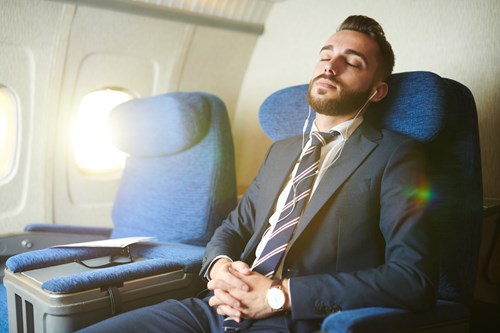How To Cope With A Fear Of Flying

Travel is a big part of millions of people’s lives. Whether you go on annual family holidays, travel regularly for business, or like to go on solo adventures overseas, flying is almost unavoidable if you’re based in the UK. While for many, flying is an exciting and enjoyable affair, for others it can be an uncomfortable, or even terrifying, experience.
Caused by a range of different factors, a fear of flying can be a real barrier to international travel. However, there are ways to ease and even fully alleviate your fears. In this guide, we take a look at some of these tactics. We also explore just how common this fear is and whether or not ‘aerophobia’ is rational.
How common is a fear of flying?
As phobias go, aerophobia - a clinically diagnosed fear of flying - is pretty common among the UK population. While many cases go undiagnosed, it is thought that between 2.5% and 5% of adults in the UK struggle with aerophobia.
Interestingly, this figure increases drastically when you include all people that experience (undiagnosed) flight-related anxiety. Indeed, it’s thought as much as 40% of the UK’s population deal with a fear of flying in some form either prior to, or during, a flight. These figures are also broadly mirrored across the globe.
Is a fear of flying irrational?
Put simply, yes - a fear of flying is generally considered irrational. This is because, statistically speaking, the fear experienced by individuals is totally disproportionate to the actual dangers posed by commercial air travel.
As an adult, you are statistically more likely to be fatally injured in a shark attack or die in a car accident than in a plane crash. In fact, overall, car travel is about 100 times deadlier than flying. Fewer than three plane accidents occur for every one million flying hours recorded. On top of this, less than 10% of people involved in these accidents suffer life-threatening injuries. The fact that most people who suffer with a fear of flying do not have similar fears about road travel highlights why it is considered an irrational fear.
How to overcome fear of flying
Just knowing a fear is irrational doesn’t mean it’s any easier to overcome. However, there are a range of methods you can try that may help to calm your nerves before and during a flight. From arriving at the airport early to keeping yourself distracted while in the air, check out our top tips.
Arrive at the airport early
The first thing you can do to keep feelings of anxiety at bay before a flight is to get to the airport in plenty of time. Setting off late, struggling to get your car parked, and having to race through security and to your gate will only add to your anxiety. It’s important to start your journey in a calm manner, and one in which you feel fully in control. With this in mind, ensure you have organised transportation to the airport that will get you there at least two hours before your flight departure time. This should give you plenty of time to make your way through security and to the gate.
If you’re driving yourself, make sure you have booked airport parking. If you are a particularly anxious flyer, it might be worth spending a little more on LJLA’s fast-track parking. This allows you to park close to the terminal and enjoy complimentary fast track security passes.
Relax in the departure lounge
Once you have passed through security, you will reach the departure lounge. If you have arrived at the airport in good time, the departure lounge is a good place to relax until it’s time to move to your gate. Typically filled with restaurants, cafes, bars and shops, there is plenty to do to keep yourself feeling calm in airport departure lounges. From a touch of retail therapy before boarding to sitting in a bar or cafe away from the hustle and bustle of the rest of the airport, finding distractions is essential in keeping anxiety at bay.
Choose an aisle seat
Nowadays, most airlines allow you to request your own seat assignment when booking a flight. If this is the case, selecting an aisle seat is a good idea if you’re an anxious flyer. Sitting on the aisle means you are less likely to feel claustrophobic, as you will be able to move freely when in the air. On top of this, if the height involved in flying is the key to your anxiety, sitting on the aisle makes it easier to avoid looking out of the windows.
Concentrate on your breathing
Although an obvious, almost cliched, tip, taking deep breaths and focusing on the pattern of your breathing is super effective. By concentrating on your breathing, you can keep your body and mind calm and prevent panic attacks. Focusing on deep breathing also helps to concentrate your attention on something other than your fear. So, if you start to feel yourself panicking when in the cabin, try to sit back and take deep, extended breaths until you feel yourself relaxing.
Keep yourself distracted
As well as using breathing exercises as a distraction technique, you can also take your mind off your fears using your choice of entertainment. Try to include something in your hand luggage that you know will keep your mind occupied for the duration of your flight. This could be a book you really want to read, a laptop or tablet complete with pre-downloaded movies, or a new podcast or audiobook on your smartphone that you’re dying to listen to. When you’re able to keep yourself distracted, you might be surprised how quickly a flight goes!